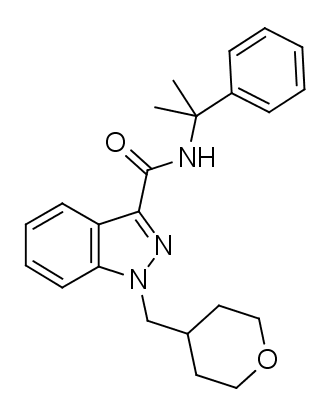Summary
CUMYL-THPINACA also recognized as SGT-42, is categorized as an indazole-3-carboxamide-based synthetic cannabinoid. This compound is a robust agonist for cannabinoid receptors, exhibiting approximately 6 times greater selectivity for CB1. Specifically, it boasts an EC50 of 0.1nM for human CB1 receptors and 0.59nM for human CB2 receptors.
| Identifiers | |
|---|---|
| IUPAC name | |
| CAS Number | 1400742-50-8 |
|---|---|
| PubChem CID | 86273679 |
| ChemSpider | 48057932 |
| UNII | 6R5GTC3QVB |
| Chemical and physical data | |
| Formula | C23H27N3O2 |
| Molar mass | 377.488 g·mol−1 |

Legal status
On November 10, 2014, Sweden’s public health agency proposed the classification of CUMYL-THPINACA as a hazardous substance. Additionally, since October 2015, CUMYL-THPINACA has been designated as a controlled substance in China.
FAQ
- What is CUMYL-THPINACA?
- CUMYL-THPINACA, also known as SGT-42, is an indazole-3-carboxamide-based synthetic cannabinoid. It is a potent agonist for cannabinoid receptors, particularly CB1 and CB2.
- How does CUMYL-THPINACA affect cannabinoid receptors?
- CUMYL-THPINACA selectively binds to cannabinoid receptors, with approximately six times greater selectivity for CB1 than CB2. This means it has a strong affinity for CB1 receptors, which are predominantly found in the central nervous system.
- What are the reported effects of CUMYL-THPINACA use?
- The specific effects of CUMYL-THPINACA use may vary from person to person. Users have reported experiences consistent with the results of other synthetic cannabinoids, including altered perception, relaxation, and heightened sensory experiences. However, it’s important to note that the use of synthetic cannabinoids can also lead to adverse effects such as anxiety, paranoia, hallucinations, and physical discomfort.
- Is CUMYL-THPINACA legal?
- The legal status of CUMYL-THPINACA varies by country and region. It has been classified as a hazardous substance in some countries and as a controlled substance in others. It’s essential to be aware of the specific regulations in your area regarding this substance.
- What are the health risks associated with CUMYL-THPINACA use?
- Like other synthetic cannabinoids, CUMYL-THPINACA poses several potential health risks. These risks include altered mental states, increased heart rate, high blood pressure, and, in some cases, severe adverse reactions such as agitation, hallucinations, and even medical emergencies. Additionally, the long-term health effects of CUMYL-THPINACA use remain a subject of concern.
- Is CUMYL-THPINACA safe to use?
- The safety of CUMYL-THPINACA use is not well-established. Due to the unpredictable nature of synthetic cannabinoids and the potential for severe adverse effects, it is strongly recommended to avoid using this substance.
- Is CUMYL-THPINACA detected in standard drug tests?
- CUMYL-THPINACA may not be detected in standard drug tests, as these tests are typically designed to identify more common substances. However, specialized tests can detect synthetic cannabinoids, so it is essential to be cautious about potential screenings.
- What precautions should I take regarding synthetic cannabinoids like CUMYL-THPINACA?
- It is advisable to avoid the use of synthetic cannabinoids, including CUMYL-THPINACA, due to their unpredictable effects and potential health risks. Always prioritize your health and well-being by making informed choices and seeking help if you or someone you know is struggling with substance use.
- Where can I find more information about CUMYL-THPINACA?
- For the latest information on CUMYL-THPINACA, its legal status, and potential health risks, it’s best to refer to official government health agencies, local law enforcement, and reputable medical sources. Stay informed and make safe choices regarding substance use.
References
- “CUMYL-THPINACA” – Source: Cayman Chemical. Retrieved on July 11, 2015.
- Monti MC, Scheurer E, Mercer-Chalmers-Bender K. (July 2021) – “Phase I In Vitro Metabolic Profiling of the Synthetic Cannabinoid Receptor Agonists CUMYL-THPINACA and ADAMANTYL-THPINACA.” Published in Metabolites, Volume 11, Issue 8, Page 470. DOI: 10.3390/metabo11080470. PMID: 34436411. PMC: 8398790.
- WO 2014167530 – Bowden MJ, Williamson JP. Published on October 16, 2014, “Cannabinoid compounds.”
- “Cannabinoider föreslås bli klassade som hälsofarlig vara.” – Retrieved on July 11, 2015.
- “关于印发《非药用类麻醉药品和精神药品列管办法》的通知” (in Chinese) – Issued by the China Food and Drug Administration on September 27, 2015. Archived from the original on October 1, 2015. Retrieved on October 1, 2015.